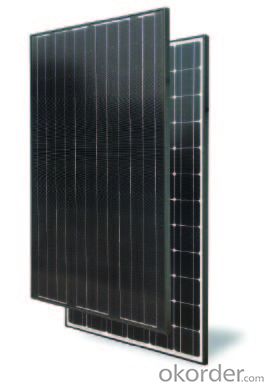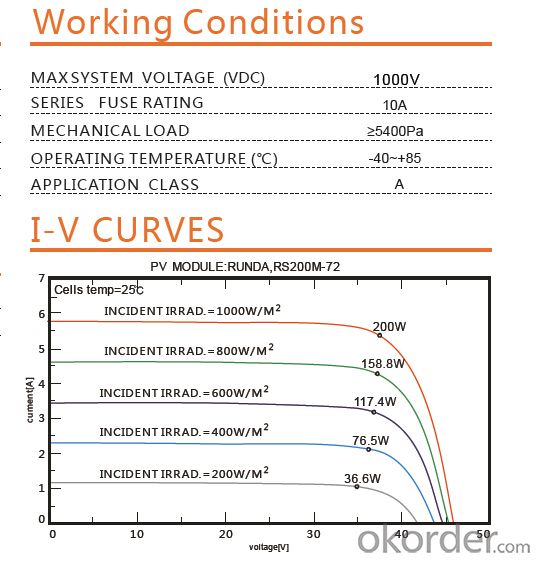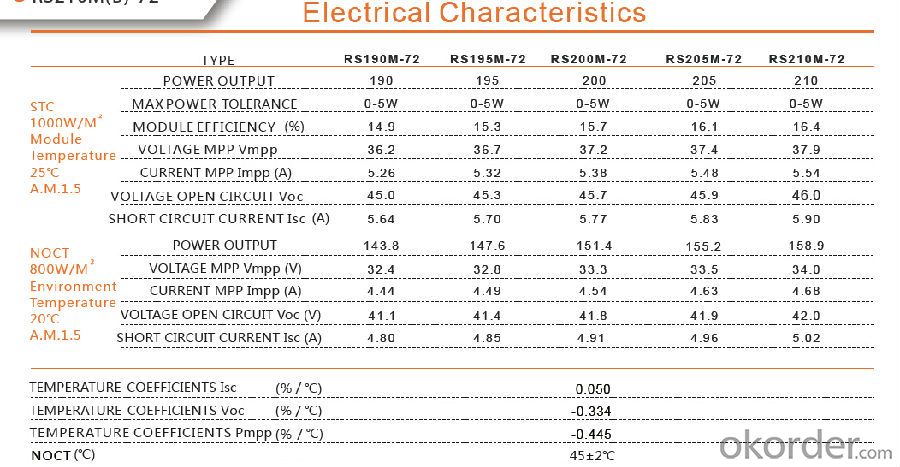Loading Port:China main port
Payment Terms:TT OR LC
Min Order Qty:2000 watt
Supply Capability:1000000 watt/month
Quality Assurance
10 Years Material & Craft
Power Guarantee
12 Years 90% Output
25 Years 80% Output
ISO9001:BSI
ISO14001:BSI
OHSAS18001:BSI
High Module Efficiency
Mechanical Load Capability up to 8000 Pa
Salt Mist Corrosion Protect Ammonia Resistance
Potential Induced Degradation Free
RS200M(B)-72
RS190M(B)-72
RS195M(B)-72
RS205M(B)-72
RS210M(B)-72



Structure of Solar Panels Description
Solar panel refers either to a photovoltaics (PV) panel, a solar hot water panel, or to a set of solar photovoltaics panels electrically connected and mounted on a supporting structure. A PV panel is a packaged, connected assembly of solar cells. Solar panels can be used as a component of a larger photovoltaic system to generate and supply electricity in commercial and residential applications. Each panel is rated by its DC output power under standard test conditions, and typically ranges from 100 to 320 watts. The efficiency of a panel determines the area of a panel given the same rated output – an 8% efficient 230 watt panel will have twice the area of a 16% efficient 230 watt panel. There are a few solar panels available that are exceeding 19% efficiency. A single solar panel can produce only a limited amount of power; most installations contain multiple panels. A photovoltaic system typically includes a panel or an array of solar panels, an inverter, and sometimes a battery and/or solar tracker and interconnection wiring.
Efficiencies
Depending on construction, photovoltaic modules can produce electricity from a range of frequencies of light, but usually cannot cover the entire solar range (specifically, ultraviolet, infrared and low or diffused light). Hence, much of the incident sunlight energy is wasted by solar modules, and they can give far higher efficiencies if illuminated with monochromatic light. Therefore, another design concept is to split the light into different wavelength ranges and direct the beams onto different cells tuned to those ranges. This has been projected to be capable of raising efficiency by 50%. Scientists from Spectrolab, a subsidiary of Boeing, have reported development of multijunction solar cells with an efficiency of more than 40%, a new world record for solar photovoltaic cells. The Spectrolab scientists also predict that concentrator solar cells could achieve efficiencies of more than 45% or even 50% in the future, with theoretical efficiencies being about 58% in cells with more than three junctions.
FAQ of Solar Panels
Q1:Can we visit your factory?
A1:Sure,welcome at any time,seeing is believing.
Q2:Which payment terms can you accept?
A2:T/T,L/C,Moneygram,Paypal are available for us.
Q3:How to guarantee the Quality of the products?
A3:We have established the international advanced Quality management system,every link from raw material to final product we have strict Quality test;We resolutely put an end to unQualified products flowing into the market. At the same time, we will provide necessary follow-up service assurance.